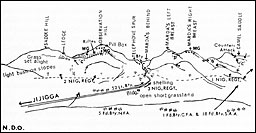
17
Into the Abyssinian Highlands
Major-General Wetherall, after a pause of only three days, thanks to the stocks of petrol discovered at Mogadishu and the use of Merca as a port, on 1 March 1941 sent off a column from 23rd Nigerian Brigade to pursue the enemy.1 Having been delayed at Mabungo through lack of fuel, and after varied adventures before starting to help 19th Field Park Company, S.A.E.C. to dismantle the pontoon bridge there, 16th Field Company, S.A.E.C--30 per cent under strength--had been placed under command 11th African Division and hurried forward to Mogadishu, which it reached on 28 February, 1941. It was immediately ordered to Afgoi to put the railway into commission, repair water-distillation plants, establish water-points and repair the bridge over the Webi Shebelli as quickly as possible. Two locomotives were quickly repaired and by the time the Nigerians moved up the road from Mogadishu the railway was already carrying material for bridge construction and the water-points at Afgoi were on the way to supplying 10,000 gallons a day.
With fifty-seven trucks immobilized at Mogadishu with broken springs at one stage, the 107th R.M.T. Company, S.A. Indian and Malay Corps there unearthed a treasure chest in the shape of a large dump of Italian spring blades. The company blacksmith took these in hand and with the help of the unit's springmaker--an Indian firewalker before volunteering--he set about refitting vehicles as opportunity occurred on halts.
Indications were that the Italians might be holding a delaying position somewhere south of Gabredarre--about halfway between Bulo Burti and Jijigga. Enemy aircraft were reported to have been sighted there on the ground and General de Simone's Headquarters were suspected to be at Dagabur, 590 miles north of Mogadishu. The Italians, in full flight, were surprised to find their columns little disturbed by air attack2--largely owing to the speed of their own withdrawal, which had outstripped the South African Air Force's ability to disengage along the Juba and move to airfields further forward.
The 101st Colonial Division, originally ordered to fall back on Cal-lafo, south of Gabredarre, had been given fresh radio instructions by the Comando Superiore, rerouting their columns to Neghelli. The rest of General de Simone's forces were ordered to fall back on Harar.3 General Baccari's command, with bombing demoralizing the Native
